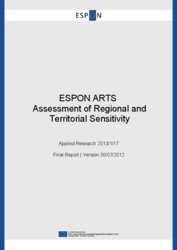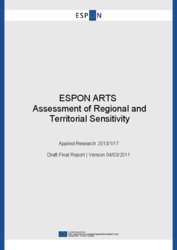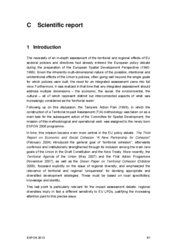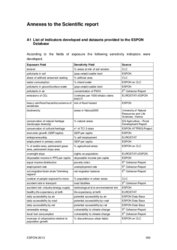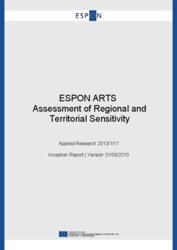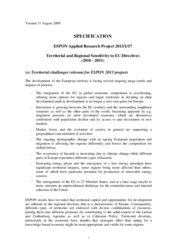ARTS - Assessment of Regional and Territorial Sensitivity
Theme
Territorial and regional sensitivity of EU Directives
Thematic scope
An effective exploitation of Europe’s territorial capital requires deeper insights into the various territorial effects of EU sector legislation and policy as well as on how they structurally reinforce each other. Policymakers increasingly acknowledge the need to consider ex ante possible territorial effects of new EU sector legislation and policy as they might have both directly and indirectly often unintended impacts on territorial organisation and development at European, (trans)national and regional level.
Policy practice shows that these impacts are sometimes felt at regional/local level instead of having a global impact for the entire European territory. The impact often varies throughout the different types of territories and regions in Europe as the sensitivity to different types of EU legislation and policy varies in the different types of territories and regions. Territorial (regional) sensitivity to EU legislation can be described as the degree to which a territory (region) is directly and indirectly affected, either adversely or beneficially by change in European legislation or policy. Territorial sensitivity hence is an important variable in Territorial Impact Analysis. In contrast to vulnerability territorial sensitivity also takes into account possible benefits but does not consider the (possible) adaptive capacity of a territory.
Policymakers in the field of territorial cohesion and development need evidence-based information that supports them in creating awareness on possible territorial impacts during the policymaking processes of sectoral EU policy and legislation. A particular consideration in this respect is the fact that regions and different types of territories are not equally affected by new EU policy and legislation. The regional sensitivity differs due to geographical, socio-economic, environmental and cultural characteristics. A good insight in the difference in regional sensitivity is considered as an important element to carry out a meaningful analysis of territorial impacts.
Please read more about the main research areas and main results envisaged on the next page.
Lead Partner
Austrian Institute for Regional Studies and Spatial Planning, Austria
Detailed information on the contracted project team can be found under Transnational Project Groups.
Sounding Board
Kai Böhme, Luxembourg
Davide Genelitti, Italy
Budget: € 247 787,50
Project’s lifetime: February 2010 – November 2011
Delivery of Reports
Inception Report: 31 August 2010
Draft Final Report: 28 February 2010
Final Report: 31 May 2011
Publishing
Reports will be published once they are approved by the ESPON Monitoring Committee
More information
Please contact the Project Expert at the ESPON Coordination Unit:
Marjan VAN HERWIJNEN, e-mail: marjan.vanherwijnen@espon.eu
Main Research Areas
- The project shall bring the ESPON Programme a step further in its supportive role to policymakers in Territorial Impact Assessment:
- It shall further elaborate the methodological framework. This project makes use of (a combination of) existing ex ante territorial impact assessment methodologies. The methodological framework is expected to comply with the current state of affairs in policymaking, in particular where awareness creation on the territorial dimension is concerned.
- The project shall define the sensitivity of the different types of territories and regions throughout Europe in relation to each of the selected EU directives.
- The project shall indicate data and indicators are needed to assess this sensitivity at the level of the individual directives and, if possible, at the level of all directives.
Main results envisaged
- A synthetic analysis in the form of guidance for policy advisors/practioners (at different policy levels) summarising territorial/regional sensitivity to different types of European directives.
- Logical (territorial) analysis of 10-15 directives and the definition of their territorial/regional sensitivity including an overview of the available data and indicators.
- In-depth case studies for three (test) European directives including a logical (territorial) analysis of the directive and the definition of territorial/regional sensitivity and an overview of the territorial impacts per policy alternative.
- Integrated cross-sector territorial indicators that serve to assess (and monitor) the territorial and regional sensitivity of sectoral European directives and policy measures.
- European maps revealing (1) the territorial sensitivity to specific types of European policy measures and (2) the territorial impact of different policy alternatives for (the three test) European directives.
